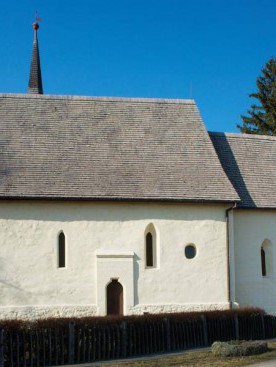The Calvinist Church – VámosatyaThe initial name of the settlement (Atya) was derived from the name of a person. The settlement was mentioned in a diploma for the first time in 1289, while its priest in 1321. The attribute Vámos was added to the name of the settlement in order to differentiate it from another commune called Atya, but situated in the Szatmár area. The village church was dedicated to Saint George and started to be used by the Calvinists around 1565. The sanctuary of the building is oriented and ends in a straight line, while the edifice itself is located in the village centre. The nave of the church has a rectangular base and is connected to a square-based sanctuary ending in a straight line. The sanctuary’s height is lesser than the nave’s height. The corners, except for the northeast corner, are decorated with beautifully carved quoin stones. On the eastern and southern walls of the sanctuary, one can see a narrow window spanned by a lancet arch. The eastern window still has some remainders of red paint on it. Three windows and the gate of the church divide its southern wall. One of the windows is circular. Another gate, enclosed in a stone frame can be found in the middle of the western wall, too. On the inside, the nave is covered with a wooden coffered ceiling made in 1769, which is separated from the sanctuary by a lancet arch. The vault in the sanctuary is a rib vault with ribs made of stone and its keystone is decorated with the coat of arms of the Gutkeled clan. The canopy suporting the rib on the southeast side is decorated with a stylised head. On the northern wall, one can see the gate of the sacristy, encased in stone, and a tabernacle spanned by a lancet arch. The southern wall is divided by a sedilia. The southern and the northern walls of the nave were covered with white lime coating, however, during restoration, the decorative painting applied in the Calvinist period of the church has been revealed in certain places. Exploration of the church started in 1971 and was followed by a restoration when an attempt was made to present all architecturally relevant details. Several smaller building inaccuracies characterise the church. Nonetheless, experts argue that it had been built during a single period, between 1289 and 1334, when the Farkas branch of the Gutkeled clan owned the village. Several churches in the area share this layout, have a sanctuary enclosed by a straight line and are covered by a groin vault ceiling combined with ribs made of stone. Some examples are the churches in Csaroda, Márokpapi and Lónya. In what regards the other side of the frontier, Kárpátalja (Subcarpathia), the churches in Nagybégány (Velika Bihany) and Técső (Tiachiv) can be included in this group. It was supposed earlier that these churches are the works of craftsmen who were in close contact with one another. Although this is somewhat uncertain, the family resemblance of the churches is obvious. Moreover, the church-route links these important memories of Hungarian medieval architecture in an interesting manner from a tourist’s point of view. |
















